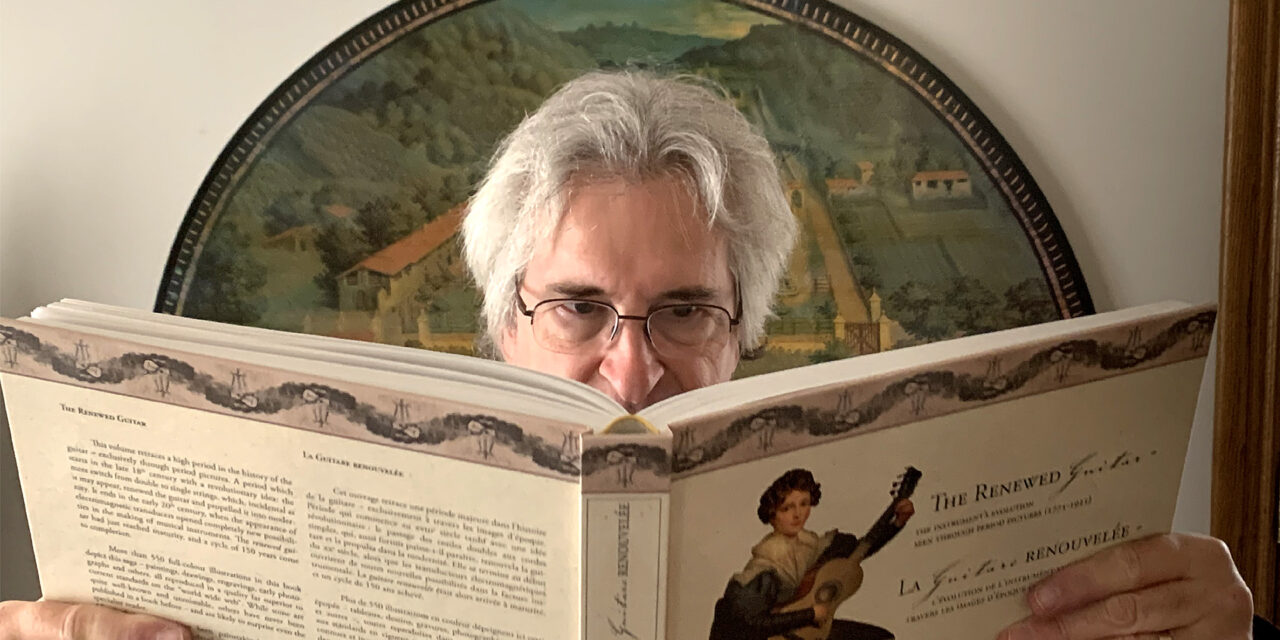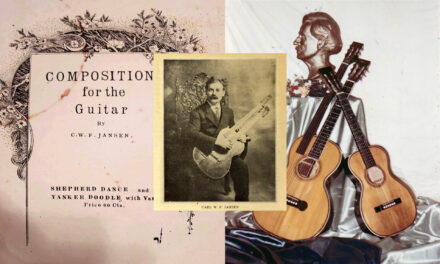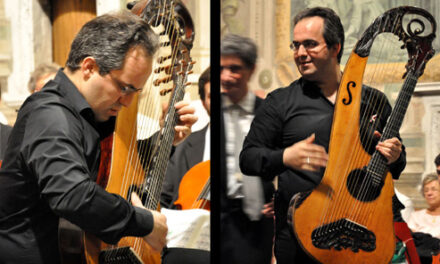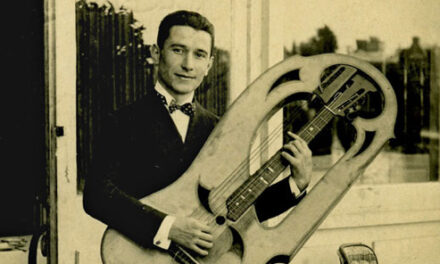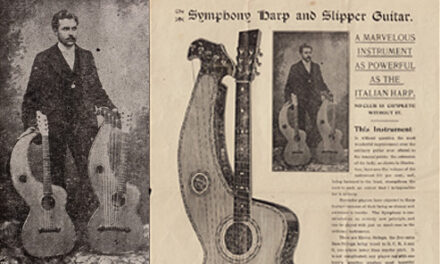
As readers know, I don’t typically “review” books or CDs in my blog but can often be found sharing my reaction to things that inspire, entertain, or best of all, amaze me. Well, here’s one!
Here we have the polar opposite of the “guitar porn” books we all love, whether the stunning publications by Sinier de Ridder or the many American tomes remaindered at Barnes & Noble. Rather than photos and descriptions of extant guitars, it contains iconography of guitars (indeed, other than within performer photographs, I don’t believe there’s a single photo of a guitar itself as an actual singular object). It thus belongs equally on the bookshelves of art lovers and serious guitar fans. Along with those art lovers, anyone truly interested in the guitar’s history – whether organological, musical or sociocultural – will not go away hungry.
Publisher Erik Hofmann and his partner-in-frets Stefan Hackl have given us another labor of love. At 7 pounds and almost a foot square and an inch and a half thick, this is a book! In its nearly 400 pages, we see what the authors consider the “renewed guitar” in its every permutation for a good century and a half (late 18th century to early 20th) in beautiful high quality, clean reproductions of artwork of every description: oil paintings, engravings, lithographs, photographs, postcards, magazine illustrations and luthiers’ labels, to name a few. From the rare treasures of individual collectors to the holdings of museums large and small, many are published here for the first time.
While each image tells part of the guitar’s story and stands alone as pure art, I enjoyed digging into the specifics. And as I’m really bad at identifying the endless European varieties of styles/localities/traditions/individual builders (especially when “hidden in this picture”), it’s really nice that the authors point out their observations and detailed identifications wherever possible. It’s a whole different level of nerdfest!
OK, as for this site’s focus, what about harp guitars?
I’d been forewarned in advance that I’d be seeing some harp guitar surprises, and I was not disappointed. Perhaps half of the dozens of images were new to me. They don’t get a “section,” they’re interspersed throughout the book (just as they’ve been throughout the guitar’s history). Included are a couple of finds that I had hoped to surprise my own readers with (having kept them to myself so the authors could get the “scoop” here – as we have some of the same sources). These and hopefully others, I’ll be unveiling in the future with more in-depth discussion where possible.
I’ve long noticed that, along with the “renaissance of the harp guitar” that we at the Gatherings and through this site (and now, social media) have seen building for decades, the same thing has happened among the more academic historians, builders and players. It was especially rewarding to read these words of Erik Hofmann in his introduction regarding his observations about historical photographs of “harp guitar” players: “The sheer number of players represented with such instruments could generate an interpretive bias: are these instruments actually overrepresented because of their aesthetic qualities, or has their importance been substantially under-estimated to this day?” (In a later chapter, his answer seems to skew toward the latter.) Semantics aside, no one is ignoring these instruments any longer.
With that kind of awareness and dedication, I was thus somewhat disheartened to see so few of the hundreds of Harpguitars.net supporters and readers among the substantial subscriber list at the back of the book. Most names that I knew are scholars and historians themselves and more in the early 6-string guitar world (though generally no strangers to “guitars with bass strings” or other multicorde guitars). Perhaps that’s just due to the increasing trend of eschewing costly publication for instant digital gratification (yeah, I’m guilty), though I fear it may also be a lessening interest in serious history and study.
Regardless, I thoroughly enjoyed all of it; I certainly saw and learned more than I expected. In fact, if I have one complaint, it’s that this thing didn’t weigh fifty pounds, as I would have loved to hear more of the authors’ thoughts and comments on certain things I expected they were dying to tell us (and I would’ve also enjoyed another thousand images, but that’s just selfish me). Hofmann and Hackl have willpower and discipline that I do not (e.g.: they used three of my images, whereas I can’t help throwing it all at you!).
Hey, I see that our U.S. dollar has actually improved recently, so friends in the States can save a few bucks if they buy now (if you’re in Europe, the thing’s a steal, frankly). P.S: A heads up for U.S. customers – the package took a long time to arrive, so don’t panic if you don’t hear anything for weeks at a time or believe it when DHL says “delivered” (it’s not their fault; things can fall into our new US Postal Service abyss).
I can pretty much guarantee that your fretted faith will be renewed with The Renewed Guitar!

